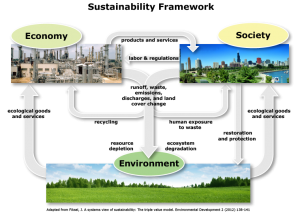The Academic Mantra 2014 is: Go for environmental studies and serve better than just an aware bearer of the problem, contribute in making a change. For all the toddlers who are asked questions about their aim in life: Remember! Green is the new cool. Let’s have a greener and sustainable revolution!
Environmental studies are the systematic understanding of our environment and our existence in it. It includes many interconnected problems involving human population, Earth’s natural resources and environmental problems and issues. It is highly interdisciplinary and integrates natural sciences, social sciences and humanities in a broad holistic study of the world around us.
Objectives of Environmental studies
The objectives and guiding principles of environmental studies are as follows:
1. Awareness: To acquire awareness and sensitivity to the total environment and its allied problems is the main and basic objective of studying another additional separate subject of Environmental Studies.

2. Knowledge: To gain experience and acquire basic understanding of the environment, its aspects and its associated problems is yet another intention behind environmental studies.

3. Attitude: To acquire set of values, develop feelings of concern for the environment, and build motivation for active participation in environmental improvement and protection.
4. Skill: To develop skills in identifying and solving environmental problems is the solution to the varied problems in the arena of environment. Thus, greener skills are embodied with the help of environmental studies.
5. Participation: To provide an opportunity to be actively involved at all levels in working towards resolving environmental problems.
Importance of Environmental Studies
The important social and economic benefits that would result from government’s initiative towards the propagation of environmental education are:
• Conservation of energy by introducing alternate sources, improved technologies and processes compatible with environment.
• Increase in economic productivity through improved health of people.

• Conservation of fast depleting natural resources and to find ways and means to maintain ecological balance through alternate resources which are renewable and environment friendly.
• Impart knowledge about waste management, treatment and disposal techniques to keep away from the hazards.

• Develop social responsibility towards control of environmental pollution and protection.
• Creating awareness in people to control population and thus pollution, which follow a large population since the amount of waste collected, is high, the demand of natural resources skyrocket, in order to meet the demand, new synthetic resources are made with the help of hazardous chemicals. Thus population is a major aspect of pollution and the environmental crisis of the generation.
• Inculcate attitude and values towards understanding the interdependence of nature and man and work towards sustainable development.
Role of Environmental Scientists
Environmental Scientists try to establish general principles about how the natural world functions. They use these principles to develop viable solutions to environmental problems based on scientific knowledge. The engineers are the real deal for the environmental issues who would promote green and environmentally safe products. The IT industry needs to take a faster pace at doing the same. Building a healthier environment is the job for the environmental engineers and scientists. We need researchers for finding out the problem and the causes and consequences, then we would need the public engagement teams for making people aware of several issues, finally we would require scientists and engineers with viable solutions.
The five elements or stages that contribute to addressing an environmental problem are:
1. Scientific assessment: The first stage is the collection of information, facts & figures. The problem is defined and then the data is collected and experiments and simulations are performed to construct a model. This model then helps to understand how the problem arose, i.e., the causes and how is it affecting the planet i.e., the consequences and finally how to predict the future course of events.
2. Risk analysis: Using the results of the scientific investigation, the potential effects or the risk of one or more remediation option is calculated.
3. Public education and involvement: In a democratic country like India, public awareness and endorsement through media is an essential part of addressing environmental problems. When alternative courses of action exist, then the affected parties i.e., the public must be informed.

This involves the explanation of the problem and the alternatives for action along with probable costs of each option.
4. Political action: The affected parties, through their elected officials decide a course of action and implement it. Ideally, the course of action is based on the best evidence. But during a political process the action is based on economic, social and political considerations rather than scientific evidence.
5. Evaluation: The results of any action taken should be carefully monitored to see if the problem is really being addressed and also to improve the initial assessment and modelling of the problem.
However, in real life, addressing environmental problems is quite complex particularly when the problem is of regional or global level. Quite often, the public becomes aware of the problem at the half way and starts discussing remediation measures before the problem is clearly identified.
“If we don’t act now, we may not have another chance to do so”.
Leave a Reply